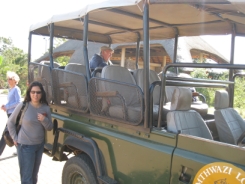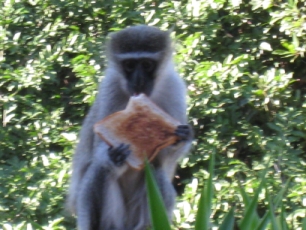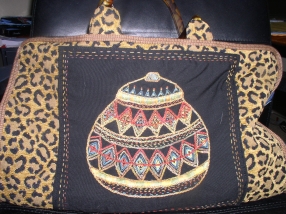 Do you have your binoculars ready, camera and hat? Remember, keep your hands inside the jeep. While on this visual African Safari remember the animals are not in cages, do not pat or feed them and most importantly remember you are a guest in thier environment!
Do you have your binoculars ready, camera and hat? Remember, keep your hands inside the jeep. While on this visual African Safari remember the animals are not in cages, do not pat or feed them and most importantly remember you are a guest in thier environment!
You can expect to see plenty of monkeys not only on safari but in various part of South Africa, in cities as well as rural areas. Troops of monkeys have made their home in different parts of South Africa, primarily in Kwa-Zulu Natal in Durban and the south coast of Durban (maybe its all those easily accessible bananas that grow so well in the climate). You can also can see monkeys in Cape Town in Chapman’s peak and outside of Johannesburg near Sun City and Pilansberg Game reserve. Monkeys are not in cages in these places and roam freely. They like swinging from trees, climbing onto roof tops , and on top of cars they often hang out with their families, with the babies clutching onto the bottom of their mothers tummies as they run, walk and climb. They are very cute to observe, however it is strongly suggested that you do not pat or feed them human food. Sometimes if you are too close to a family of monkeys they will feel threatened and do not always appreciate you taking pictures. They will let you know how they feel. If a male monkey does not want you coming close or taking photographs, he will start flaying his arms and hissing. Since this happened to us on a trip to South Africa, we learned from my  father-in-law never to turn your back on the monkeys.
father-in-law never to turn your back on the monkeys.
Perhaps because of the climate and lush vegetation in Durban, South Africa monkeys abound. From my in-laws' house in Durban, South Africa, you can see monkeys from the window. When we go down the north coast and stay inside a monkey reserve, frequently we will wake up to find monkeys on the roof, on the patio, and swinging from branches outside. As long as you do not try to feed the monkeys or bother them and their babies, they are quite content to let you observe them. I love observing their mischevious behaviour and often human-like manner. Baboons and chimpanzees are popular mammals you can expect to meet. This picture in my blog was taken while at San Lameer, we were having breakfast on the patio and before i knew the monkey had grabbed my toast, I could not resist this picture.
Durban, which is also the home of the Zulu tribe, is where you can expect to find many hand woven baskets. In rural areas in South Africa, people create art out of indigenous materials, such as clay, wood, and grass, and make richly decorated items for household purposes such as serving spoons, silverware, bowls, etc. Beading of  these items is very common and is a craft practiced by many in southern Africa. Some rural communities even create art out of recycled items such as Coca Cola tins. Traditionally, the men do most of the wood carving and the women the beading. Women make most of the items that are sold commerciallly, and do this while raising their children at home in the rural communities, while husbands work in the cities. Many of these women are now being encouraged by development agencies to produce work for outside markets to be sold in the rest of the world - an example of this is the Ndebele dolls that I showed you in my last post. You can read more about African tribal arts in my book "Safari through African Folklore Embroidery", now available on AnnTheGran's website.
these items is very common and is a craft practiced by many in southern Africa. Some rural communities even create art out of recycled items such as Coca Cola tins. Traditionally, the men do most of the wood carving and the women the beading. Women make most of the items that are sold commerciallly, and do this while raising their children at home in the rural communities, while husbands work in the cities. Many of these women are now being encouraged by development agencies to produce work for outside markets to be sold in the rest of the world - an example of this is the Ndebele dolls that I showed you in my last post. You can read more about African tribal arts in my book "Safari through African Folklore Embroidery", now available on AnnTheGran's website.
With all this talk about monkeys, I've included a picture of our African Folklore Embroidery Monkey Super kit. I've also put in another picture of a pot, because the inspiration for these designs is from the many African women who make and weave beautiful baskets out of grass. This is from our African Basket Kit. Traditionally these baskets and pots were used to store grain and other items, these days they are produced to be sold and to earn income for the women. Speaking of earning income for women, I am giving readers of this blog post 15% off all of the African Folklore Embroidery kits for this week. You can see the whole selection by clicking here.
grain and other items, these days they are produced to be sold and to earn income for the women. Speaking of earning income for women, I am giving readers of this blog post 15% off all of the African Folklore Embroidery kits for this week. You can see the whole selection by clicking here.
Look out for my next post on the BIG FIVE, THE RULES OF AFRICAN FOLKLORE EMBROIDERY AND ANIMALS YOU WOULD NOT EXPECT BUT WILL SEE IN SOUTH AFRICA.
Salang hantle! ("Stay Well!", in the Sotho language)
Leora